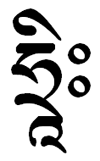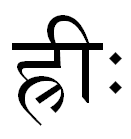Kurukullā Mantra
Kurukullā is possibly an Indian tribal deity who was assimilated by Buddhists. She became associated with Tārā and is sometimes called Red Tārā. Incidently she was also adopted into the Hindu pantheon. In many ways she is similar to the ḍakiṇī figures such as Vajrayoginī.
Her name derives from the her residence on Kurukulla mountain in Lāṭadeśa (in present day Gujarat). In Tibetan her name is རིག་བྱེད་མ (rig-byed-ma) which means "she who is the cause of knowledge".
Kurukullā is particularly associated with the Red Rite, the Tantric Rite of Fascination or Subjugation (vaśikaraṇa).
She is red in colour, dancing on a red lotus and as Lokesh Chandra says "she beams with love in all the freshness of youth".
The Red Rite is on the mundane level associated with attracting lovers, and on the transcendental level relates to the Sameness Wisdom of Amitābha. Her seed syllable hrīḥ emphasises her relationship to Amitābha.
There are some variations in her iconography but she is always shown with a pulled back bow and arrow both covered in flowers. The flowery arrow will remind westerners of Cupid,
the Roman equivalent of the Greek Eros, who is depicted as a cherub who goes about shooting people with arrows that make them fall in love. She also often holds an elephant goad and a noose, both of which are used to help to subjugate lovers.
Seed Syllable
Amitābha's bīja mantra is hrīḥ which is ha + ra + ī + ḥ (visarga)
| Siddhaṃ | Tibetan - Uchen | Devanāgarī |
Mantra
Siddhaṃ
Tibetan - Uchen
Devanāgarī
ओं कुरुकुल्ले हूं ह्रीः स्वाहा
Transliteration
oṃ ku ru ku lle hūṃ hrīḥ svā hā
It is common to see the mantra without the hūṃ, that is: oṃ kurukulla hrīḥ svāhā, however the basic mantra is given with the hūṃ by Lokesh Candra and Stephen Beyer
Notes
Kurukulle is the vocative singular of the name Kurukullā, meaning that she is being addressed by name.






